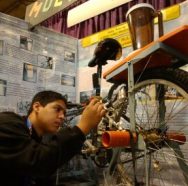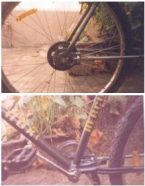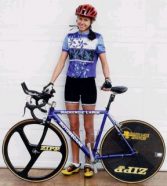Tinkering With the Basic Bike
Turning a bicycle into a blender, and making it go faster and farther with less effort.
Bicycles are a great way to get around. They’re fun to ride, especially down hills. And, as you whiz along the road, you might also think of ways in which you could improve your bike—make it safer, more efficient, more comfortable, or more versatile. In fact, the two-wheeled machines make for some cool science projects.
This year’s Intel International Science and Engineering Fair (ISEF), held last May in Cleveland, featured three bicycle projects from three countries. Like many of the other experiments presented at ISEF, the bike projects showed that some of the most interesting scientific research often begins by taking a closer look at things you care about.
One student from Oklahoma, for example, used computer programming to make a three-dimensional model of the movements of his pet spider. Two young women from Puerto Rico found evidence that playing violent video games raises people’s blood pressure and heart rate, potentially making them angrier.
Electricity bike
Renato Angulo Chu had even grander ambitions. The 12th-grader from Lima, Peru, wanted to address some of his country’s economic troubles.
“I see a problem in my country,” Renato said. “If you go to the forests in Peru, in some places you cannot find electricity. If you go with my bicycle, you can turn on the lights.”
Renato, 16, spent 3 years designing his special Multibike. The contraption looks like a stationary exercise bike. It has wires strung along the frame and a blender strapped to the back. Turning the pedals operates the blender. The same principle can be used to sharpen knives or sweep city streets.
 |
|
Renato Angulo Chu adjusts his blender-equipped Multibike. |
| ISEF |
The Multibike can work either as a stationary bike or as a bicycle able to travel city streets and country roads. It’s made from inexpensive materials, and the user gets exercise while pedaling to operate a machine.
“You pedal the bike, and you can mix any drink you want,” Renato said. More importantly, he added, the same concept could be used to bring light to houses in remote regions of the rainforest.
Where’s the chain?
Ronak Tak and Anish Menon, two high school seniors from Jaipur, India, just wanted to find a more efficient way to get around.
“In our country, 95 percent of people use bicycles as their main means of transportation,” said Anish, who rides his bike about 4 kilometers to school every day. Ronak added, “We wanted to do an experiment that was . . . beneficial for the common man.”
So, the 17-year-olds invented a chainless bicycle. A bicycle’s chain creates problems, the students said. Without regular oiling, it can rust, reducing the bike’s efficiency. When it’s oiled, there’s the nuisance of stains when hands or clothing touch the chain.
Ronak and Anish started by removing the chain assembly from an ordinary bike. Then, they used rods (or shafts) to connect the pedals and the wheel. Their new axle-rod assembly resembled that found in trucks and buses. When the pedals rotate, the rod moves, which in turn rotates the bicycle’s wheel.
 |
|
Two views of the axle-rod assembly developed by Anish Menon and Ronak Tak to replace a bicycle’s chain. |
| Anish Menon |
The result is much more efficient than a regular bike, Anish said. “It feels more comfortable. The stress on your legs is reduced. You can go a much longer distance using the same number of pedals.”
Ronak added, “It’s compact. It’s durable. You don’t have to worry about getting grease on your pants.”
To put numbers where their mouths were, Ronak and Anish did laboratory tests to compare their chainless prototype with a regular bike. They applied equal amounts of force to both bikes in rotating the pedals one full time around. Using an instrument called a tachometer, they measured how fast the rear wheel spun.
In test after test, the chainless bike outperformed the chain-equipped bike. Without the resistance of a chain, the back wheel rotated an average of 66 times in a 30-second trial. With a chain, the rear wheel made it around only an average of 47 times. That difference could shave up to 5 minutes off a 30-minute journey, the inventors estimated.
So “shift to shaft” has become their motto. And they plan to make more. “When we first explained our idea, some people said, ‘You are totally mad,'” Ronak said. “But we never quit. Quitters never win.”
Racing wheels
Winning is exactly what Mackenzie LaRoe likes to do. The 15-year-old triathlete from Eustis, Fla., is ranked seventh in the country in the Junior Elite division of her rigorous sport, which combines running, swimming, and cycling. The high school freshman is also an aspiring scientist who made it to ISEF with an experiment designed to identify the fastest wheels for her bike.
She tested three types: a regular set of wheels; a set of racing wheels with fewer spokes; and a set of specialty wheels with a spokeless disk for a rear wheel and only three wide spokes in the front wheel.
For each wheel set, Mackenzie did six trials. She used the same bicycle, wore the same clothes, and held the same body position. In each trial, she coasted down the same hill for about half a mile. The only variable was the wind.
Her father helped her time each trial (and drove her back up the hill). Each time, she recorded her maximum speed and her average speed.
Results matched her expectations: The fastest wheels were the ones with the fewest spokes. On the specialty set, she averaged 42.72 kilometers per hour, compared with 39.89 km/h and 42.15 km/h for the first two.
 |
|
Mackenzie LaRoe displays her bike’s fastest wheels. |
| LaRoe |
I suggested she might want to try one of Ronak and Anish’s ultraefficient chainless bikes for her next race. She hadn’t seen the invention, but she had heard about it. “I’d have to see what it’s like,” she said. “That’d be something to try, but races usually have restrictions about bicycle specifications.”
Lessons learned
None of the bike projects took home any of the big prize money presented at ISEF this year. But their designers learned plenty of surprising things.
Renato saw how exercise might power a village. Mackenzie learned that science can be fun, especially when it involves cruising down hills at 40 km/h all afternoon. “It was exhilarating!” she said. “I wasn’t in the lab all day long.”
Studying bikes can even bring a little fame, Ronak and Anish discovered. They have been riding their chainless prototype around Jaipur so much that many of the city’s 3 million residents now recognize them when they pass.
“We’re famous in our city,” Ronak said. “When we go by, everyone says ‘There goes the chainless bicycle!'”
Word Find: Improving the Bicycle
Going Deeper:







